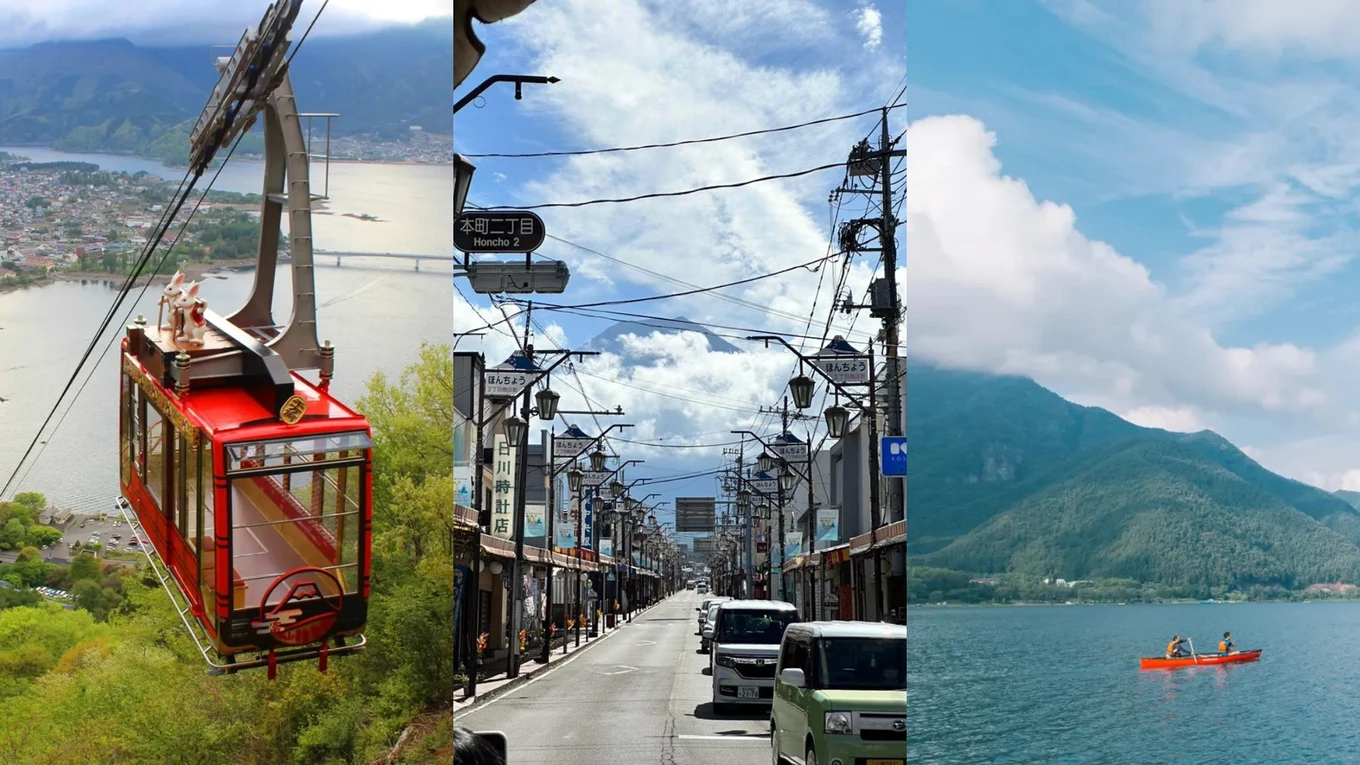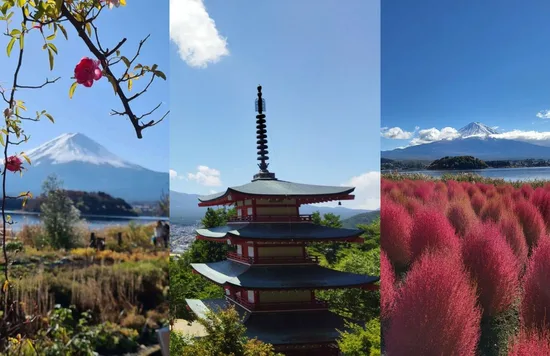Best Spots for Mount Fuji Views
Standing at 3765 meters tall, Mount Fuji is Japan’s tallest mountain! This almost perfectly shaped volcano is one of the most popular and iconic Japanese sites. Helmed and worshiped as a sacred mountain, here are some of the best places to spot this majestic beauty. We’ve also included instructions on how to get there from Tokyo for easy reference!
Embark on a journey to the majestic Mount Fuji, towering impressively at a height of 3765 metres, making it the tallest mountain in Japan! Renowned for its near-perfect symmetrical form, this iconic volcano holds a special place in Japanese culture, often regarded as a sacred mountain. Whether you're an experienced hiker, a nature enthusiast, or someone seeking views, Mount Fuji offers an unforgettable experience.
Discover the best vantage points to witness the magnificent Mount Fuji. From classic viewpoints to hidden gems, we've curated a list of places that promise breathtaking vistas of this natural wonder. Each location offers a unique perspective, allowing you to appreciate the beauty and serenity of this iconic peak.
Read more about Mt Fuji here: Mount Fuji Guide for the First-timers
To make your journey seamless, we've provided detailed instructions on how to reach Mount Fuji from Tokyo. Whether you prefer a scenic train ride, a mix of transports, or the convenience of the Fuji Excursion train, we've got you covered. This guide ensures that your encounter with Mount Fuji is not only memorable but also hassle-free.
So, gear up for an adventure, embrace the spiritual aura surrounding Mount Fuji, and capture moments that will stay etched in your memory forever!
Pray hard to the weather gods because you’ll need a beautiful clear day in order to spot this beauty. In general, you’ll have the highest chance in winter( November to February), the lowest in summer (June to August), and early mornings are best.
Apart from that, there is also the Fuji Shibazakura festival where the base of the mountain is covered with pink sakura! This festival happens from mid-April to May.
How to get to the Sacred Mountain from Tokyo
By JR Pass and Mt Fuji Pass: Take the JR Chuo Line from Shinjuku Station to Otsuji Station and hop onto the Fujikyu Railway from Otsuki Station to Kawaguchiko Station.
Klook Tip: Sit on the “D” aisle of seats (right side) from Tokyo to Fuji for the best views of the mountain on your way there.
By Hakone Free Pass: Hop onto the Odakyu line train from Shinjuku and transfer to the Hakone Tozan bus or train to Mt Fuji.
By Fuji Excursion Train: The Fuji Excursion train takes you from Tokyo straight to Kawaguchiko! This entire ride is covered by the JR East Pass (Tohoku and Nagano/Niigata).
Navigating Tokyo's busy public transport can be overwhelming, but worry not! Klook offers an array of fantastic day trips from Tokyo, providing a hassle-free solution for those seeking convenience and memorable experiences. Say goodbye to the complexities of researching transport passes and optimal viewing spots; Klook has meticulously curated day trips that cater to your preferences.
Whether you're an adventurer, a culture enthusiast, or someone who simply wants to unwind, Klook has tailored day trips to suit your interests. From exploring historical landmarks to immersing yourself in the natural beauty of surrounding areas, each trip is designed for maximum enjoyment.
Forget the stress of planning; Klook takes care of the logistics, leaving you to savor the journey. Expertly crafted itineraries, comfortable transportation, and knowledgeable guides await you, promising an enriching and stress-free adventure.
Let Klook be your travel companion, turning your day trips from Tokyo into unforgettable escapades. Explore with ease and indulge in the wonders that Japan has to offer, all without the hassle of navigating the intricate web of public transportation. Your perfect Tokyo day trip awaits!
Mount Fuji transport essentials
1. Mount Fuji Pass
2. Hakone Free Pass
Image from Odakyu
Now that you’ve gotten your transport all settled here are the best spots to catch this beauty!
Places with the best Mount Fuji view
1. Lake Kawaguchi (Kawaguchiko)
The Fuji Goko (Fuji five lakes) are located on the northern side of Mount Fuji and include the Kawaguchiko, Motosuko, Saiko, Shojiko, and Yamanakako lakes. If you’ve seen a photo of the famous reflection shot of Fuji on the lake, this is probably the best place for you to replicate it.
The most famous of the lakes is Lake Kawaguchi and it’s probably the most accessible as well. The best place to get the panoramic views of Mt Fuji is from the north side of the lake.
Getting there: Hop onto the Red line of the Fujikyuko Sightseeing Bus and alight at the Kawaguchiko Museum of Art and the lake is a short walk away.
2. Lake Yamanaka (Lake Yamanakako)
Lake Yamanaka is the largest lake and offers stunning views of Fuji from the northern shore. We’d suggest renting a bike and cycling around the lake! You can rent a bicycle near the bus stop for approximately JPY1500-2000 for 4 hours.
Getting there: Take the Fujikko-Go bus to Yamanakako stop.
3. Lake Sai (Lake Saiko)
Lake Sai offers a clear view of Fuji from the western shore and there are a couple of viewpoints that offer stunning views except you’ll need to hike to get there. The first is a 30-minute hike to Koyo-Dai, a lookout point between the lake and the Fuji Panorama Line. You can even stop by the Narusawa Hyoketsu (Ice Cave) and Fugaku Fuketsu (Wind Cave) nearby, these are covered with your Mount Fuji Pass.
There is also an onsen spa called the Fuji Yurari Hot Spring where you can soak in the hot springs with Mt Fuji in view!
Getting there: Take the blue line of the Fujikyuko sightseeing bus and get off at the Koyo-Dai Entrance stop.
4. Lake Shoji (Shojiko)
Lake Shoji is the smallest of the 5 lakes but shows what is one of the great views of Mt Fuji! Come at sunset and you’ll find a gathering of photographers seeking the perfect Fuji sunset shot. If you’re up for it, there is also a 4-hour return hike called the Panorama Dai. It starts from Lake Shoki and offers a full view of the lake and Fuji!
Getting there: Take the Fujikyu bus to Panorama Observatory stop for the Panorama Dai hike, and Kodaki Fuji View stops for the western shore with Fuji views.
5. Lake Motosu (Motosuko)
Lake Motosu is probably the least accessible of the lakes but definitely should not be missed. This is where you’ll find the famous 1000-yen bill viewpoint of Mount Fuji! The walk to this viewpoint will set you back 1 hour each way but we think it’s worth it for sure.
Getting there: Take the Fujikyu bus to the Kodaki Fuji View stop. The famed viewpoint is next to Motosu Central Lodge and Koan Campground on the northwestern side.
6. Mt Fuji 5th Station
Standing at 2300 metres above sea level, this is probably the closest you can get to Mount Fuji without climbing. The Mount Fuji 5th Station is the halfway mark of Mt Fuji so you’ll only be able to see half of the mountain. You’ll catch sight of hikers on their way up to the peak and this is where they’ll stock up on supplies like snacks, water, and even oxygen.
Getting there: Hop onto the Fujikyu bus and alight at the Fuji Subaru Line 5th Station.
7. Mt Fuji Panorama Ropeway
For a more panoramic view of the mountain, hop onto the Mt Fuji Panorama Ropeway (Kachi Kachi Yama Ropeway) from the eastern shore of Lake Kawaguchiko. If you’re up for it, you can also choose to hike up instead of taking the ropeway, the return journey will take you slightly under 2 hours.
The ride on the Kachi Kachi Ropeway is included in the Mount Fuji Pass.
Once you’ve reached the observation deck, you can also take a 2-hour hike to Mount Mitsutoge which offers you a different perspective of Mount Fuji.
Getting there: Take the red line of the Fujikyuko sightseeing bus from Kawaguchiko to the “Pleasure Cruiser/Ropeway Entrance” stop
8. Fuji Q Highland
Who can forget the Fuji Q Highland theme park, the only place in Japan where you can ride a roller coaster AND enjoy the views of Fuji at the same time? Home to the world’s steepest roller coaster the Takabisha and the fastest accelerating roller coasting the DoDonpa, this is not for the faint-hearted.
Klook Tip: Pre-book your Fuji Q tickets on Klook to skip the line and enter the park directly!
Getting there: Almost every highway bus to the Fuji Five Lakes area stops at Fuji-Q Highland, otherwise hop onto the Fujikyu line and alight at Fuji-Q Highland.
9. Chureito Pagoda
The 2nd most iconic shot of Mt Fuji is probably this one with the Chureito Pagoda. This 5-story pagoda or shrine is best visited in the morning when you’ll catch Fuji in its full glory and you won’t have to fight with the mobs of people! During Spring, you’ll even get photobombed by plenty of Cherry Blossoms!
Getting there: Catch a 10-minute train from Kawaguchiko to Shimo-Yoshida. The Pagoda is a 10-minute walk away
10. Lake Ashi (Ashinoko)
The classic view of Mt Fuji with the orange Torii gates of the Hakone Shrine can be captured from Lake Ashi. Hop onto a pirate boat and sail around this stunning lake, which is included in the Hakone Free Pass. This crater lake is extremely popular with hikers due to the abundance of nature all around.
Getting there: Use your Hakone Free Pass and hop onto the Odakyu train at Shinjuku and alight at Lake Ashinoko.
Embark on an incredible journey to Mount Fuji, Japan's iconic and tallest mountain, standing proudly within the bounds of a national park. The mountain's summit, a haven for artistic inspiration, unveils breathtaking views that are nothing short of mesmerising.
Plan your visit during the climbing season for clear views and an opportunity to witness the magnificence of this active volcano. With proper safety measures, guides, and knowledge in place, you can explore not just the summit but also other facilities that enhance your understanding of the region's volcanic activity.
Mount Fuji is not just a mountain; it's a canvas of nature's marvels, beckoning adventurers and seekers of unparalleled beauty to experience its grandeur.


























![[Updated] Complete List Of Official Nationwide MCO SOP 2021](https://res.klook.com/image/upload/fl_lossy.progressive,q_85/c_fill,w_160,h_104/v1633858858/blog/iso56uzsphmdguixkvzh.webp)





![[Updated] Complete List Of Official Nationwide MCO SOP 2021](https://res.klook.com/image/upload/fl_lossy.progressive,q_85/c_fill,w_410,h_264/v1633858858/blog/iso56uzsphmdguixkvzh.webp)







